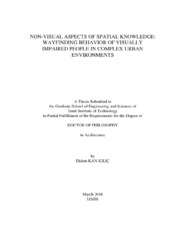Please use this identifier to cite or link to this item:
https://hdl.handle.net/11147/4875Full metadata record
| DC Field | Value | Language |
|---|---|---|
| dc.contributor.advisor | Doğan, Fehmi | en_US |
| dc.contributor.author | Kan Kılıç, Didem | - |
| dc.date.accessioned | 2017-02-21T10:47:39Z | - |
| dc.date.available | 2017-02-21T10:47:39Z | - |
| dc.date.issued | 2016-03 | - |
| dc.identifier.citation | Kan Kılıç, D. (2016). Non-visual aspects of spatial knowledge: Wayfinding behavior of visually impaired people in complex urban environments. Unpublished doctoral dissertation, İzmir Institute of Technology, İzmir, Turkey | en_US |
| dc.identifier.uri | http://hdl.handle.net/11147/4875 | - |
| dc.description | Thesis (Doctoral)--İzmir Institute of Technology, Architecture, İzmir, 2016 | en_US |
| dc.description | Full text release delayed at author's request until 2019.04.08 | en_US |
| dc.description | Includes bibliographical references (leaves: 173-180) | en_US |
| dc.description | Text in English; Abstract: Turkish and English | en_US |
| dc.description | xiii, 258 leaves | en_US |
| dc.description.abstract | Everybody perceive space multi-dimensionally however blind people are more conscientious of the non-visual constituents of space. Although there is an extensive amount of research on mobility, perception, and way-finding of blind people, there has been fewer work to show which specific aspects of built environment they focus on and they use as cues in the way they relate to their urban environment. Therefore, this study focuses on the senses of blind individuals during their way-finding process in urban contexts. Two case studies in İzmir, Turkey and Lisbon, Portugal were conducted in large-scale urban contexts. The case study in İzmir highlights the holistic and multi-dimensional perception of space by asking 9 congenitally blind participants to mark those places that they find particularly important in Kemeralti and İzmir Fair Park by verbally describing the features in the environment they attend to. It was found that auditory information was the most used environmental cues and a feeling of enclosure is the most important environmental feature during way-finding. The second case study in Lisbon was conducted with 5 congenitally blind participants to understand the strategies of congenitally blind participants with a focus on whether sounds from the environment are of primary importance for blind individuals. The most important finding is that increased familiarity with the environment, the better way-finding strategies blind individuals have. This study highlights multi-dimensional sensory experience of urban environments and non-visual aspects of spatial perception. | en_US |
| dc.description.abstract | Herkes mekanı çok boyutlu olarak algılar, ancak körler mekanın görsel olmayan boyutlarını algılamada daha titizdirler. Körlerin hareketliliği, algıları ve yön bulmalarına yönelik çok fazla çalışma bulunmasına karşın, çevreleriyle ilişki kurarken hangi ipuçlarını kullandıkları ve nelere odaklandıklarına dair çok az çalışma bulunmaktadır. Bu sebeple, bu çalışma, kör bireylerin yön bulma sürecinde kentsel mekanda kullandıkları duyulara odaklanmaktadır. İzmir, Türkiye ve Lizbon, Portekiz olmak üzere büyük ölçekli kentsel mekanlarda iki örnek çalışma yapılmıştır. İzmir’de yapılan örnek çalışma mekanın çok boyutlu ve bütüncül algılanmasını vurgulamaktadır. Bu vurgulama, doğuştan kör 9 katılımcının Kemeralti ve İzmir Fuar bölgelerinde bulundukları ortamlarda onlar için özel öneme sahip noktaların özelliklerini sözel olarak tanımlamaları istenerek yapılmıştır. Bu çalışmada, işitsel bilginin yön bulma sürecinde en çok kullanılan çevresel ipucu ve kuşatılma duygusunun bu süreçte en önemli mekansal özellik olduğu bulunmuştur. Lizbon’da yapılan ikinci çalışma, doğuştan kör 5 katılımcının işitsel duygularının yön bulmada öncelikli öneme sahip olup olmadığına odaklanarak katılımcıların yön bulma stratejilerini anlamak için gerçekleştirilmiştir. Katılımcıların çevreye olan aşinalığı arttıkça, yön bulma stratejilerinin iyileşmesi bu çalışmanın en önemli bulgusudur. Bu çalışma, kentsel çevrenin çok boyutlu duyusal deneyimini ve mekansal algının görsel olmayan boyutlarını vurgulamaktadır. | en_US |
| dc.language.iso | en | en_US |
| dc.publisher | İzmir Institute of Technology | - |
| dc.publisher | Izmir Institute of Technology | en_US |
| dc.rights | info:eu-repo/semantics/openAccess | en_US |
| dc.subject | Wayfinding | en_US |
| dc.subject | Visually impaired | en_US |
| dc.subject | Urban context | en_US |
| dc.subject | Multi-dimensional perception | en_US |
| dc.subject | Senses | en_US |
| dc.title | Non-visual aspects of spatial knowledge: Wayfinding behavior of visually impaired people in complex urban environments | en_US |
| dc.title.alternative | Mekansal bilginin görsel olmayan boyutları: Görme engellilerin karmaşık kentsel çevrelerde yön bulma davranışları | en_US |
| dc.type | Doctoral Thesis | en_US |
| dc.authorid | TR179972 | en_US |
| dc.institutionauthor | Kan Kılıç, Didem | - |
| dc.department | Thesis (Doctoral)--İzmir Institute of Technology, Architecture | en_US |
| dc.request.email | didem.kan@ieu.edu.tr | - |
| dc.request.fullname | Didem Kan Kılıç | - |
| dc.relation.publicationcategory | Tez | en_US |
| item.languageiso639-1 | en | - |
| item.fulltext | With Fulltext | - |
| item.openairecristype | http://purl.org/coar/resource_type/c_18cf | - |
| item.openairetype | Doctoral Thesis | - |
| item.grantfulltext | open | - |
| item.cerifentitytype | Publications | - |
| Appears in Collections: | Phd Degree / Doktora Sürdürülebilir Yeşil Kampüs Koleksiyonu / Sustainable Green Campus Collection | |
Files in This Item:
| File | Description | Size | Format | |
|---|---|---|---|---|
| T001533.pdf | DoctoralThesis | 9.47 MB | Adobe PDF |  View/Open |
CORE Recommender
Page view(s)
204
checked on Jul 22, 2024
Download(s)
178
checked on Jul 22, 2024
Google ScholarTM
Check
Items in GCRIS Repository are protected by copyright, with all rights reserved, unless otherwise indicated.